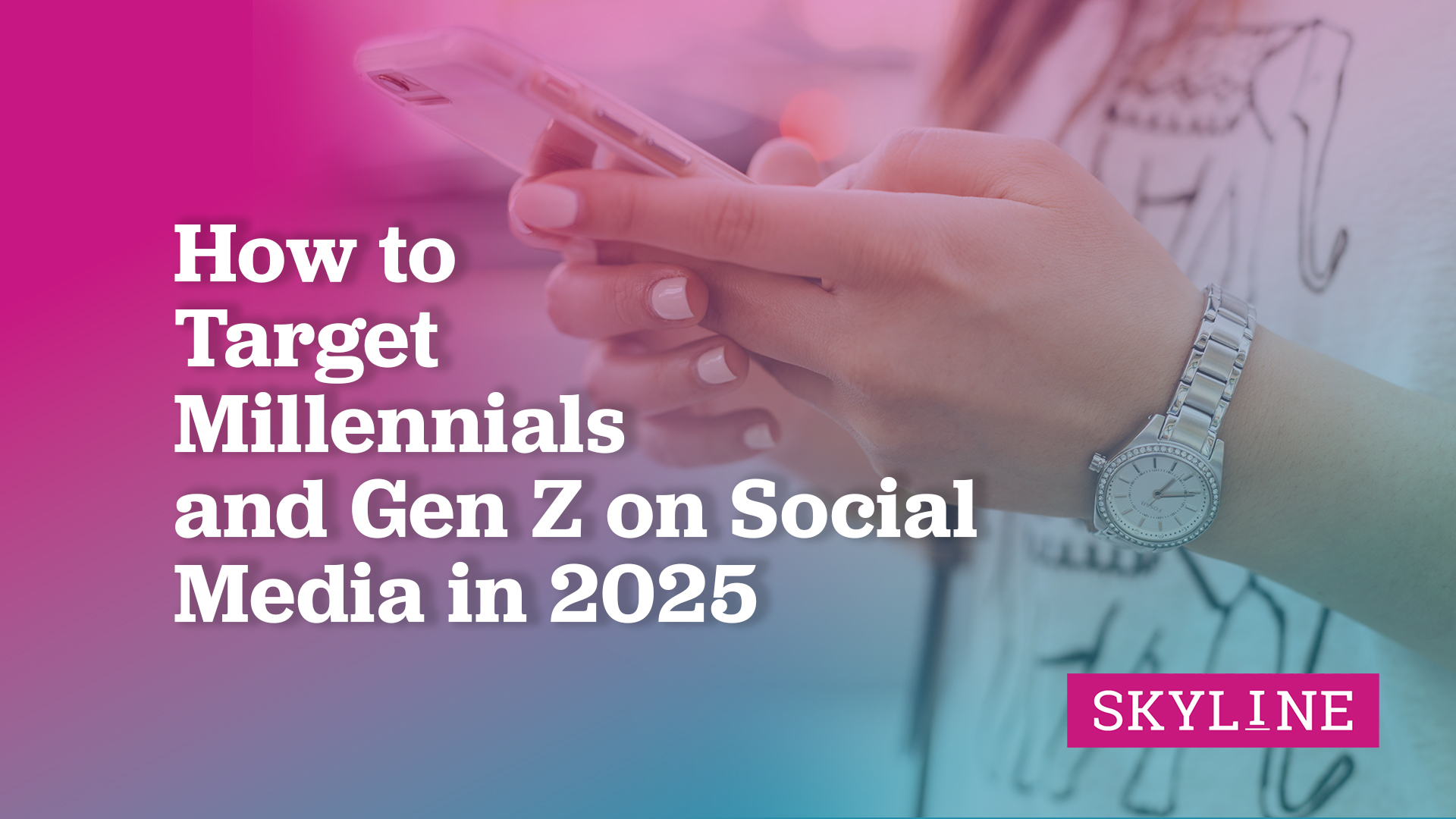Social media marketing continues to be a significant marketing strategy, especially when targeting Millennials and Gen Z—the two largest consumer groups.
According to research, social media advertising spending is projected to reach $276.7 billion in 2025, with 83% of that ad spend total generated on mobile by 2030. So, learning how to target Millennials and Gen Z on social media is crucial to brand growth.
As these generations evolve, so do their habits, preferences, and the platforms they frequent. Brands and marketers must understand how to connect with them in an authentic, relevant, and engaging way.
Keep reading this guide to explore the most effective strategies for reaching Millennials and Gen Z on social media in 2025.

Understanding the differences between Millennials and Gen Z can unlock many brand opportunities.
Before diving into the specifics of social media marketing for these groups, it’s essential to understand who Millennials and Gen Z are and how they differ.
- Millennials (born 1981-1996): Millennials are between the ages of 29 and 44. They are digital natives who witnessed the rise of social media and the internet, but many still recall a time before it. Millennials value experiences over material possessions and strongly prefer brands that offer authenticity, transparency, and social responsibility.
- Gen Z (born 1997-2012): Gen Z are currently aged 13-28. They are digital natives, having grown up with smartphones, social media, and the gig economy. Gen Z values individuality, creativity, and social causes. They are skeptical of traditional advertising and often turn to influencers and user-generated content for recommendations.
What is the social media landscape in 2025?
To successfully target Millennials and Gen Z, it’s essential to understand which social media platforms they frequent and how they interact with content.
According to research, social media ads are the leading source of brand awareness among internet users aged 16 to 34. For this reason, marketers need to understand where young consumers are spending their time to engage and target them.
Here are some statistics that can guide your strategy:
TikTok
The short-form video app continues to be the leading platform for Gen Z, with over 82% of Gen Z users in the U.S. actively engaging with content daily.
TikTok’s algorithm promotes short, engaging, and visually dynamic videos, making it ideal for creative campaigns. According to Sprout Social, TikTok offers a potential advertising reach of 1.6 billion users.
The photo and video-sharing app remains a popular platform for Millennials and Gen Z, but its role has shifted. Gen Z prefers to use Instagram for customer care over any other channel.
Instagram Stories, Reels, and Shops are essential for reaching both demographics. According to research, Instagram is the top channel for product discovery, with 61% of users using it to find their next purchase. Market research indicates that Instagram offers a total potential ad reach of 1.7 billion users.

YouTube
The video app continues to dominate as the go-to platform for video content, with Gen Z and Millennials using it regularly for entertainment, education, and shopping inspiration. The video platform’s YouTube Shopping experience lets Creators promote products from their stores or other brands across YouTube.
Video is the most preferred content for both generations, and both long-form and short-form content are essential. Audiences spend more time on YouTube than on any other social platform.
Determining whether brands should prioritize Facebook is challenging and depends on individual performance metrics.
However, the platform’s widespread user base, strong marketing capabilities, and unmatched ability to drive direct purchases make it a compelling option. According to research, millennials continue to favor Facebook, with 69% using it compared to other social media platforms. Meanwhile, only 37% of Gen Z users are active on the platform.
Six strategies to target Millennials and Gen Z in 2025 and beyond.
1. Authenticity is key to capturing the younger generations.
Millennials and Gen Z prefer to interact with brands that value authenticity. They like brands that are transparent, socially responsible, and engaged in meaningful conversations. Research indicates that 97% of Millennials and 96% of Gen Z want honest, transparent communication and consistency in brand interactions.
How to apply this:
- Behind-the-scenes content: Give followers a peek into your company’s processes, from how products are made to how your team collaborates. Doing so builds trust and makes your brand appear more relatable.
- Be consistent in messaging: Ensure your brand’s messaging aligns with its values, especially regarding social causes like sustainability, equality, and inclusion.
- Engage in real-time conversations: Respond promptly and humanely to customer inquiries and feedback. Use social listening tools to monitor brand sentiment and engage in meaningful dialogue.
2. Embrace short-form video content to educate Millennials and Gen Z on products and services.
Millennials and Gen Z are avid consumers of short-form video content, which is the preferred format for both generations to learn about new products.
According to research, 57% of Gen Z and 42% of Millennials prefer short-form videos like TikTok and Instagram Reels over other formats to learn about products and their features.
How to apply this:
- Create snackable, engaging videos: Focus on content that grabs attention quickly, whether a product demo, a tutorial, or a behind-the-scenes look at your brand. Ensure the first few seconds hook your audience, as Millennials and Gen Z have short attention spans.

- Incorporate user-generated content (UGC): Encourage users to share their experiences with your product and feature their content on your platforms. Building trust and promoting authenticity.
- Leverage trends and challenges: Participate in popular TikTok or Instagram challenges to increase your brand’s visibility. Marketers can tap into a larger, more engaged audience by doing so.
3. Influencer marketing helps build trust with your younger audiences.
Influencer marketing remains one of the most effective ways to reach Millennials and Gen Z.
However, the type of influencer you partner with matters. Gen Z prefers micro-influencers (those with 10k-100k followers) over celebrities or macro-influencers due to their perceived authenticity and relatability.
How to apply this:
- Partner with influencers who align with your brand: Look for influencers who share your brand’s values and have an engaged following. Gen Z trusts influencers more than traditional celebrities.
- Micro and nano-influencers are highly effective: While they may have smaller audiences, their followers are often more loyal and engaged, making them an ideal choice for brands targeting these demographics.
- Encourage content creation: Instead of just promoting products, influencers should create content that tells a story or provides value to their followers, whether through tutorials, reviews, or product demonstrations.
4. Interactive and engaging features provide real-time interaction with consumers.
Interactive content is a surefire way to engage Millennials and Gen Z on social media. Polls, quizzes, challenges, and live streams allow brands to interact with their audience in real-time.
How to apply this:
- Use polls and quizzes on Instagram: Polls, quizzes, and “this or that” questions encourage followers to engage directly with your brand.
- Host live events and streams: Live streaming is increasingly popular among both generations. Consider hosting product launches, Q&A sessions, or behind-the-scenes streams to engage your followers in real time.
- Gamify your content: Create challenges or reward systems where users can earn points, badges, or prizes for interacting with your content.

5. Focus on social commerce to increase purchase intent.
Social commerce is rising, with platforms like Instagram, TikTok, and Facebook fully integrated with shopping features. Millennials and Gen Z increasingly use social media to make purchasing decisions.
Primarily since, nowadays, most platforms, like TikTok, Facebook, and Instagram, provide direct shopping experiences on their platforms. New platforms like WhatNot are also elevating the shopping experience on social media.
According to Statista, about 70% of Gen Z and over nine out of ten millennial shoppers in the U.S. purchased an item they had previously seen on their social media feed.
How to apply this:
- Optimize your social media shop: Ensure your products are available directly on Instagram and TikTok. Simplify the purchasing process to make it seamless for users to buy from you.
- Leverage shoppable ads and posts: Promote your products directly within the social media experience using shoppable posts and ads. This reduces friction for users and increases the likelihood of conversions.
- Offer exclusive deals: Offer special discounts or promotions to users who follow you on social media or engage with your posts, incentivizing both generations to interact with your brand more often.
6. Prioritize sustainability and social impact to develop brand loyalty with younger consumers.
Millennials and Gen Z are deeply concerned with social and environmental issues. Brands that demonstrate a commitment to sustainability and social responsibility are likelier to win their loyalty.
How to apply this:
- Promote eco-friendly practices: Whether through sustainable products, packaging, or carbon-neutral shipping, ensure your audience is aware of your brand’s efforts toward sustainability.
- Support social causes: Partner with charities or engage in social issues that resonate with your audience, such as racial equality, mental health, or LGBTQ+ rights.

Millennials and Gen Z dominate social media, but their preferences and behaviors continue to evolve.
To effectively target these groups, brands must adapt to the latest social media trends. By understanding and embracing these shifts, you can create campaigns that resonate deeply with these audiences and drive meaningful engagement and conversions.
By consistently listening to these generations’ preferences and creating authentic and innovative content, you can position your brand for success in the competitive world of social media marketing.
